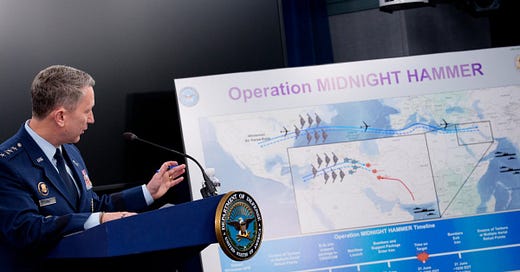Operation Midnight Hammer: How the U.S. Conducted a Surprise Strike on Iran and What It Means for the World
PARIS - In the predawn darkness of June 17, 2025, U.S. military assets—alongside Israeli counterparts—launched a lightning strike on Iranian nuclear facilities in a covert mission now known as “Operation Midnight Hammer.” Within hours, explosions were confirmed near Natanz, Fordow, and Isfahan, key sites tied to Iran’s uranium enrichment infrastructure. The strikes stunned global observers and sent diplomatic shockwaves rippling across the Middle East and beyond.
What set this operation apart was not just its precision or strategic objectives, but its sheer audacity—a high-risk, high-stakes act of undeclared warfare, launched without congressional approval and in near-total secrecy.
As the dust settles, the Free Society Foundation investigates how the operation was planned, why it was executed, and the cascading consequences it may trigger for global security, diplomacy, and the fragile balance of power in the Middle East.
The Operation: What Happened and How
According to military and diplomatic sources briefed anonymously, Operation Midnight Hammer was the culmination of months of secret coordination between U.S. Central Command (CENTCOM) and the Israeli Defense Forces (IDF). The strike involved:
Stealth B-2 Spirit bombers taking off from Diego Garcia in the Indian Ocean.
Israeli F-35I “Adir” fighters, modified for long-range precision strikes, flying from airbases in the Negev.
Cyber disruption units temporarily disabling Iranian radar systems and communications networks minutes before the assault.
Kinetic strikes on hardened underground facilities, using GBU-57 “bunker buster” munitions capable of penetrating over 60 meters of reinforced concrete.
All told, at least three nuclear-related sites were targeted, with Fordow—the underground facility buried deep in the Alborz mountains—suffering significant structural damage, according to satellite imagery analyzed by independent sources.
The operation reportedly lasted under 90 minutes, but its political and military ramifications will reverberate for years.
The Strategic Logic: Why Now?
Multiple motives converged behind the timing of the strikes:
Iran’s Enrichment Surge: The IAEA had recently confirmed that Iran’s uranium stockpile exceeded 120 kg of 60% enriched material—just short of weapons-grade. Western intelligence feared Iran could “break out” and assemble a bomb in under three months.
Israeli Pressure: Prime Minister Netanyahu, increasingly isolated at home, reportedly pressured Washington for joint action, warning that delay would “leave Tel Aviv vulnerable to nuclear blackmail.”
Trump’s Political Calculus: Former President Donald Trump—now the Republican frontrunner—endorsed the strike, seeing it as a chance to reassert American strength and distract from domestic legal and political controversies. His allies framed it as a message to both Tehran and Biden.
Window of Opportunity: With Iran distracted by internal protests and Russia bogged down in Ukraine, the operation exploited a rare moment of regional vulnerability.
Yet for all its tactical justification, the strike bypassed traditional congressional oversight—raising alarms about executive overreach and the militarization of diplomacy.
International Reaction: Praise, Panic, and Polarization
The global response was immediate—and divided.
Israel hailed the mission as “a decisive blow to the nuclear threat.”
Saudi Arabia and the UAE, while not formally endorsing the strikes, issued statements blaming Iran for “regional instability.”
France and Germany expressed deep concern over the legality and risk of escalation.
Russia and China issued a joint condemnation, warning of “grave consequences” and calling for an emergency UN Security Council meeting.
Meanwhile, energy markets surged:
Oil rose to $124/barrel as traders feared a retaliatory closure of the Strait of Hormuz.
Defense stocks soared on Wall Street and Tel Aviv exchanges.
The Iranian rial plunged nearly 30% against the dollar, prompting panic buying in Tehran.
Tehran’s Response: Strategic Patience or Proxy Escalation?
Despite the provocations, Iran has so far avoided direct retaliation. Supreme Leader Khamenei issued a stern but vague warning: “Our enemies will taste the consequences at a time of our choosing.”
Intelligence sources suggest Iran may opt for asymmetric responses:
Cyberattacks on Western infrastructure.
Houthi missile launches on Red Sea shipping.
Hezbollah cross-border incursions into northern Israel.
Targeted assassinations of U.S.-linked assets in Iraq and Syria.
But the key question remains: will Iran accelerate its nuclear ambitions out of desperation, or double down on diplomatic resistance and soft-power leverage?
The Legal and Ethical Quagmire
Operation Midnight Hammer was conducted without a formal declaration of war, raising serious legal questions:
Violation of Iranian sovereignty, with no clear UN mandate.
Breach of the War Powers Resolution, as no congressional vote was held.
Risk of setting a precedent for preemptive, extrajudicial strikes on perceived threats.
The operation may be strategically justifiable, but its implications for international norms are profound. If preemptive strikes become normalized, what is to stop other nations—say, India and Pakistan, or China and Taiwan—from citing “imminent threat” as justification for unilateral force?
Global Implications: A Dangerous Precedent
Operation Midnight Hammer has opened Pandora’s box:
Military-first foreign policy is back, sidelining years of nuclear diplomacy.
Iran’s internal hardliners are emboldened, as moderates are marginalized.
NATO is split, with some members worried about being dragged into a wider war.
China and Russia see opportunity, portraying the U.S. as destabilizing and untrustworthy.
For a world already struggling with inflation, climate stress, and rising authoritarianism, this operation risks turning the Middle East into the next great-power chessboard.
Conclusion: The Hammer Falls—But on Whose Head?
Operation Midnight Hammer was a feat of military coordination, technological sophistication, and political brinkmanship. But its success—measured in damaged centrifuges and silenced radars—must now be weighed against the strategic cost: a Middle East on the edge, and a world more uncertain than ever.
The Free Society Foundation remains committed to scrutinizing the consequences of unchecked power, wherever it manifests. As the fog of war thickens, so too must the clarity of our analysis.
The strike may have been surgical, but its aftershocks will be anything but.






